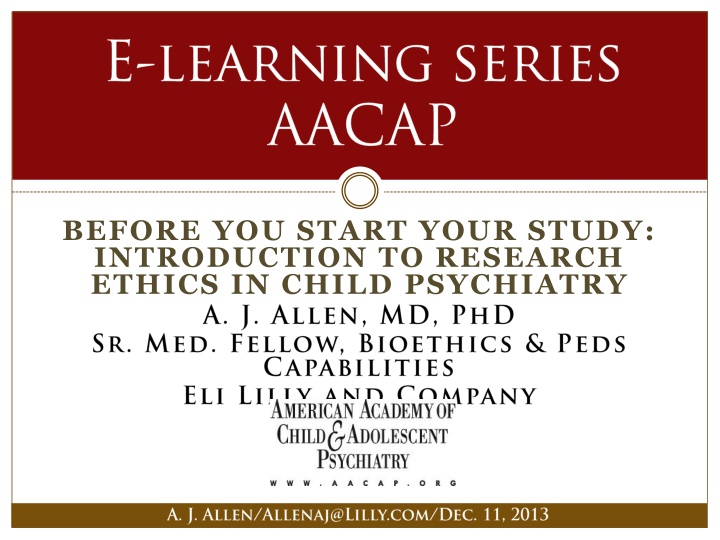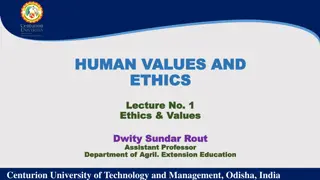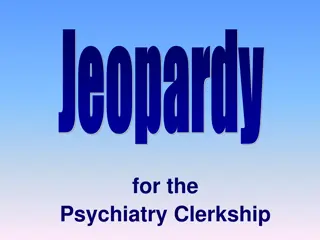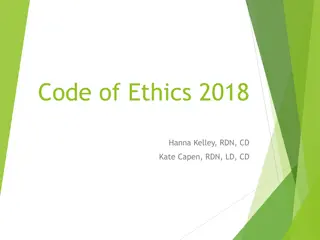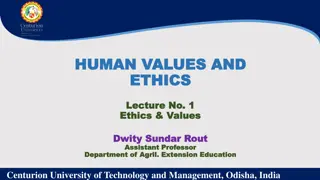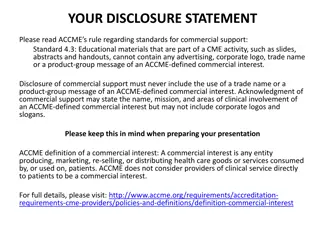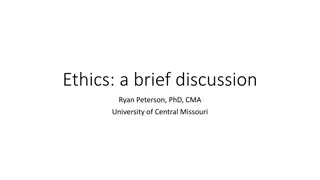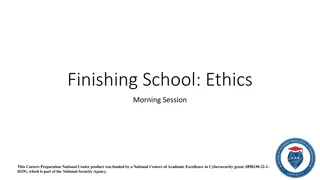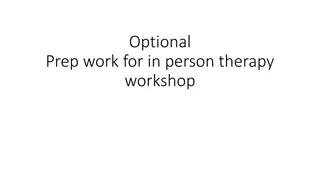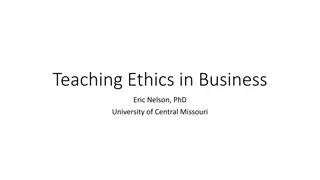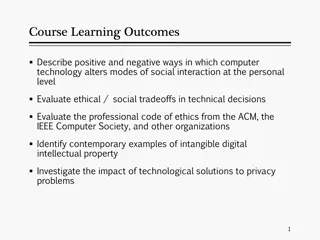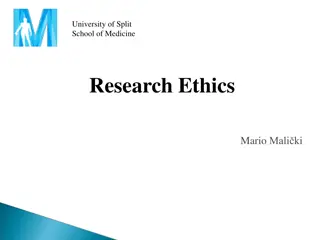Research Ethics in Child Psychiatry: Introduction and Historical Perspectives
This presentation provides an introduction to research ethics in child psychiatry, emphasizing the importance of ethical considerations in conducting studies involving children. It highlights key ethical principles, historical events shaping research ethics, and examples of past unethical practices. The content covers disclosure of conflicts of interest, responsible investigator conduct, and regulatory frameworks for protecting human subjects in research.
Download Presentation

Please find below an Image/Link to download the presentation.
The content on the website is provided AS IS for your information and personal use only. It may not be sold, licensed, or shared on other websites without obtaining consent from the author.If you encounter any issues during the download, it is possible that the publisher has removed the file from their server.
You are allowed to download the files provided on this website for personal or commercial use, subject to the condition that they are used lawfully. All files are the property of their respective owners.
The content on the website is provided AS IS for your information and personal use only. It may not be sold, licensed, or shared on other websites without obtaining consent from the author.
E N D
Presentation Transcript
BEFORE YOU START YOUR STUDY: INTRODUCTION TO RESEARCH ETHICS IN CHILD PSYCHIATRY
Disclosures of Potential Conflicts Source Research Funding Advisor/ Consultant Employee Books, Intellectual Property In-kind Services (example, travel) Stock or Equity Honorarium or expenses for this presentatio n or meeting Speakers Bureau Lilly X X X SACHRP X (SGE) X
Disclosure No medications will be discussed during this presentation.
Disclaimer The opinions expressed are those of the presenter and in no way reflect an official opinion of Eli Lilly and Company.
Overview Short history for context The Belmont Report and basic principles Other research ethics sources US regulations for the protection of human subjects Subpart D: Children Other subparts Investigator responsibilities Resources
Partial History of Shame 1940s: Nazi medical experiments Occurred in spite of pre-Nazi German laws Resulted in the US drafted Nuremberg Code 1966: Henry Beecher s NEJM article identifying 22 instances of published human subject research involving unethical practices Willowbrook State School study exposing severely mentally disabled children and adolescents to hepatitis virus 1972: 40 year Tuskegee syphilis study revealed
Partial History of Shame (continued) Sept. 16, 1999: Jesse Gelsinger, an 18 year old healthy volunteer, dies in gene therapy experiment at U. Penn Inadequate preclinical research in advance Lead researcher had financial ties to gene therapy company that were not disclosed to study subjects Study team violated approved protocol procedures intended to protect subjects
SUPPORT Trial IRB reviewed and approved double-blind, randomized trial involving pre-term infants Investigating outcomes (including death and blindness) of different levels of oxygen saturation The two oxygen saturation levels were at the extremes of the range normally used in practice at the time Controversy erupted over whether the informed consent document adequately described the risk of the trial, including the possibility of death and blindness
SUPPORT Trial (continued) August 28, 2013 Federal hearing involving NIH, FDA and OHRP Resource page: http://www.hhs.gov/ohrp/newsroom/rfc/Public%20Meeting %20August%2028,%202013/aug28public.html Presentations: https://www.youtube.com/playlist?list=PLrl7E8KABz1Gc_ndt 9grGg8O_jE5G1RNC&feature=edit_ok Two parent presentations: https://www.youtube.com/watch?v=n1USAH0PMu0&list=PLrl 7E8KABz1Gc_ndt9grGg8O_jE5G1RNC&index=22 https://www.youtube.com/watch?v=mzLubIgWGP8&list=PLrl7 E8KABz1Gc_ndt9grGg8O_jE5G1RNC&index=23
SUPPORT Trial (continued 2) August 28, 2013 Federal hearing involving NIH, FDA and OHRP Presentations (continued): https://www.youtube.com/playlist?list=PLrl7E8KABz1Gc_ndt 9grGg8O_jE5G1RNC&feature=edit_ok Neonatologist and grand parent presentation: https://www.youtube.com/watch?v=SmWJnOp1QaU&list=PLrl7E 8KABz1Gc_ndt9grGg8O_jE5G1RNC&index=10 Nice summary presentation: https://www.youtube.com/watch?v=1Hunhqfz8C4&list=PLrl7E8 KABz1Gc_ndt9grGg8O_jE5G1RNC&index=28
Belmont Report Product of National Commission for the Protection of Human Subjects of Biomedical and Behavioral Research (est. 1974) Response of Congress to the Tuskegee revelations Discussions by commission members turned into report by commission staff Outgrowth of 4 day meeting at Smithsonian Institution s Belmont Conference Center in February, 1976
Belmont Report 2 Final version published: April 18, 1979 Statement of basic ethical principles and guidelines that should assist in resolving the ethical problems that surround the conduct of research with human subjects http://www.hhs.gov/ohrp/humansubjects/guidance /belmont.html
Belmont Report TOC Boundaries between practice and research Basic ethical principles Respect for persons Beneficence (implicitly includes nonmaleficence) Justice Applications Informed consent Assessment of risk and benefits Selection of subjects
Declaration of Helsinki Product of the assembly of the World Medical Association (WMA) Triggered by Nazi experiments Produced by medical organization (physicians) First adopted in 1964 Amended 6 7 times (most recently in 2008 October, 2013) and clarifying notes added twice Has been a source of controversy at times in a number of areas http://www.wma.net/en/30publications/10policies/ b3/
Declaration of Helsinki (continued) 2013 version reorganized as 37 statements in 12 sections Preamble General principles Risks, burdens and benefits Vulnerable groups and individuals Scientific requirements and research protocols Research ethics committees Privacy and confidentiality Informed consent Use of placebo Post-trial provisions Research registration and publication and dissemination Unproven interventions in clinical practice
International Committee on Harmonization (ICH) Guidance documents are products of agreements between FDA, EMA, PMDA, PhRMA, EFPIA, JPMA Biopharmaceutical oriented guidance ICH E6 covers Good Clinical Practices (GCPs) http://www.ich.org/fileadmin/Public_Web_Site/ICH_Produc ts/Guidelines/Efficacy/E6_R1/Step4/E6_R1__Guideline.pdf Includes ethics and protection of human subjects Responsibilities sections: IRB/IEC (section 3) Investigators (section 4) Sponsors (section 5) FDA requires foreign studies comply with ICH E6 16
International Committee on Harmonization (ICH, continued) Ethics also included in other guidance documents as well Example, E11: Clinical Investigations of Medicinal Products in the Pediatric Population http://www.ich.org/fileadmin/Public_Web_Site/ICH_Products/ Guidelines/Efficacy/E11/Step4/E11_Guideline.pdf Section 2.6 deals with Ethical Issues in Pediatric Studies 17
CIOMS International Ethical Guidelines for Biomedical Research Involving Human Subjects CIOMS = Council for International Organizations of Medical Sciences Collaboration with WHO Document produced by panel of international experts in bioethics http://www.cioms.ch/publications/layout_guide2002.pdf First issued in 1993 Revised in 2002 21 comprehensive guidelines
CIOMS International Ethical Guidelines for Biomedical Research Involving Human Subjects 2 Document produced by panel of international experts in bioethics (continued) Longer than Declaration of Helsinki Addressed vulnerable groups 10+ years before DoH Specifically addresses research involving children (DoH still does not)
Sampling of Various Countries Ethics Regulations, Guidelines, Codes, etc. Council of Europe Guide for Research Ethics Committee Members: http://www.coe.int/t/dg3/healthbioethic/source/INF(2011)_e n.pdf Indian Council of Medical Research Ethical Guidelines for Biomedical Research on Human Participants: http://icmr.nic.in/ethical_guidelines.pdf Nigerian National Code of Health Research Ethics: http://www.nhrec.net/nhrec/National_Code_for_Health_Res earch_Ethics_v2.0.pdf
Global Challenges President s Commission for the Study of Bioethics Issues (PCSBI): www.bioethics.gov Rules, standards, and practices vary greatly around the globe (but) Almost all international codes and national laws and regulations seem to promote the basic principles of: Respect for persons Beneficence Justice PCSBI: Research Across Borders, 2011 21
Global Challenges (continued) Almost all international codes and national laws and regulations agree specifically about certain fundamental requirements, such as: Minimizing risk Obtaining informed consent Requiring independent review of research. PCSBI: Research Across Borders, 2011 22
Equal Principles, But Variable Emphasis Based On History, Philosophy, Politics, Culture, etc.? Respect for Persons (Autonomy) (USA) Beneficence & Non-maleficence (Germany) Justice (India or China)
US Regulations Protecting Human Subjects Involved in Research Regulations developed based on recommendations of the National Commission for the Protection of Human Subjects of Biomedical and Behavioral Research ( THE National Commission, est. 1974) Established as a result of Tuskegee syphilis study disclosures OHRP regulations (perspective of agencies funding human subjects research): 45CFR46 FDA regulations (perspective of agency regulating drug and device development research involving human subjects): 21CFR50 Often referred to as The Common Rule
US Regulations Protecting Human Subjects Involved in Research (continued) Common Rule regulations govern: Composition, functioning, roles and responsibilities of institutional review boards (IRBs) Informed consent (and assent) There is a proposal to add investigator responsibilities (see later slides) IRBs and informed consent are the primary tools for protecting human subjects Important to recognize these are not the only tools (e.g. data safety monitoring boards, DSMBs, and FDA s GCP regulations regarding responsibilities of investigators and sponsors)
US Regulations Protecting Human Subjects Involved in Research (continued 2) 45CFR46 (OHRP) Subparts Subpart A: Basic HHS Policy for Protection of Human Research Subjects Subpart B: Additional Protections for Pregnant Women, Human Fetuses and Neonates Involved in Research Subpart C: Additional Protections Pertaining to Biomedical and Behavioral Research Involving Prisoners as Subjects Subpart D: Additional Protections for Children Involved as Subjects in Research Subpart E: Registration of Institutional Review Boards
US Regulations Protecting Human Subjects Involved in Research (continued 3) 21CFR50 (FDA) Subparts Subpart A: General Provisions Subpart B: Informed Consent of Human Subjects Subpart C: Reserved Subpart D: Additional Safeguards for Children in Clinical Investigations Subpart E: Does not exist Other FDA regulations cover registration of IRBs, good clinical practices, data safety monitoring boards, etc.
US Regulations: 45CFR46 (OHRP) and 21CFR50 (FDA), subpart D Re: Children 46.404/50.51 Clinical investigations not involving greater than minimal risk 46.405/50.52 Clinical investigations involving greater than minimal risk but presenting the prospect of direct benefit to individual subjects 46.406/50.53 Clinical investigations involving greater than minimal risk and no prospect of direct benefit to individual subjects, but likely to yield generalizable knowledge about the subjects' disorder or condition. The risk represents a minor increase over minimal risk
US Regulations: 45CFR46 (OHRP) and 21CFR50 (FDA), subpart D (continued) 46.407/50.54 Clinical investigations not otherwise approvable that present an opportunity to understand, prevent, or alleviate a serious problem affecting the health or welfare of children 46.408/50.55 Requirements for permission by parents or guardians and for assent by children. 46.409/50.56 Wards
What is classic component analysis? A clinical investigation may include more than one intervention or procedure. Each intervention or procedure must be evaluated separately to determine whether it does or does not hold out the prospect of direct benefit to the enrolled child. This classic approach is consistent with the recommendations of the National Commission (1978) and the resulting regulations. Interventions or procedures that hold out the prospect of direct benefit should be considered under 21 CFR 50.52. Interventions or procedures that do not hold out the prospect of direct benefit should be considered under 21 CFR 50.51 or 50.53 (but not 50.52). 30
Investigator Responsibilities FDA already addresses in GCP regulations SACHRP proposed in March, 2013 that OHRP regulations also address: http://www.hhs.gov/ohrp/sachrp/commsec/attachmentc- sec.letter19.pdf Not official yet, requires a notice of proposed rule making and public comment period New 46.104 Responsibilities of Investigators. 13 requirements (e.g., ensuring staff qualifications and training, IRB review, obtaining informed consent, etc.) New 46.105 Qualification Standards for Investigators. 2 requirements (e.g., education, training and experience)
Investigator Responsibilities (continued) SACHRP proposed in March, 2013 that OHRP regulations also address (continued): http://www.hhs.gov/ohrp/sachrp/commsec/attachmentc- sec.letter19.pdf New 46.106 Investigator Records, Reports and Documentation. 5 requirements (e.g., how long to retain records)
Overview - Conclusion Short history for context The Belmont Report and basic principles Other research ethics sources US regulations for the protection of human subjects Subpart D: Children Other subparts Investigator responsibilities Resources (after question slide)
Questions? ALLENAJ@LILLY.COM
OHRP Resources These resources apply to all Federal departments and agencies that follow the Common Rule OHRP regulations page: http://www.hhs.gov/ohrp/humansubjects/index.html OHRP policy and guidance page: http://www.hhs.gov/ohrp/policy/index.html OHRP vulnerable populations page (includes children): http://www.hhs.gov/ohrp/policy/populations/index.html
FDA Resources FDA Clinical Trials and Human Subject Protection Page: http://www.fda.gov/ScienceResearch/SpecialTopics/Running ClinicalTrials/default.htm FDA protection of human subjects and GCP regulations page: http://www.fda.gov/ScienceResearch/SpecialTopics/Running ClinicalTrials/ucm155713.htm#FDARegulations FDA pediatrics page: http://www.fda.gov/scienceresearch/specialtopics/pediatricth erapeuticsresearch/default.htm
CITI Training Collaborative Institutional Training Initiative (CITI) Run out of Univ. of Miami Research ethics training courses Used by many institutions and IRBs in the US and internationally CME available https://www.citiprogram.org/
PRIM&R Public Responsibility In Medicine & Research (PRIM&R) Professional organization composed of investigators, research staff, IRB members, human research protection professionals, others Promotes highest ethical standards in research Holds regional and national training conferences International outreach programs http://www.primr.org/
